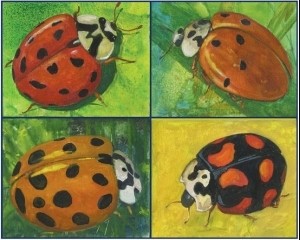
The ladybeetle family includes many cute and shiny beetles – they’re usually bright orange or red, with some black and white thrown in for contrast. As a group, they specialize in consuming agricultural pests, especially aphids, and they don’t sting or bite. These attributes and the fact that there are so many of them – about 5,000 species worldwide and around 475 in the U.S. – have contributed to making ladybeetles among the most beloved of all the insects.
In the old days, ladybugs (as they’re often called) used to “fly away home” to their children, as per the old nursery rhyme. Now one species, the Halloween ladybeetle, is instead flying into our homes in droves, where its bad odor and habit of falling into cups of coffee has contributed to its dramatic fall from grace.
Properly called the multicolored Asian ladybeetle, this little insect has so many other names that in the U.K. it’s sometimes known as “the many-named ladybird.” What we know as “ladybugs” are called “ladybirds” in other English speaking countries. Again, properly, they are not bugs or birds; they are beetles.
This species is unusually varied in appearance, ranging from pale orange to deep red, occasionally with no spots and sometimes with as many as 16 spots, but it does have a distinctive feature: between the wings and the head, on the prothorax, are markings in black and white that can be read as a “W” or an “M.”
In 1888, an Australian species of ladybeetle was brought to America to control a scale insect that threatened the California citrus crop – this was the very first recorded case of a predatory insect being deliberately imported to the U.S. The release was enormously successful, so much so that it spurred the widespread and haphazard release of various ladybeetle species all around the world.
The Halloween ladybeetle, native to eastern and central Asia, soon became a favorite for biological control projects because it eats a wide variety of insects in the egg and larval form. Since its introduction in 1916, the species has devoured aphid species that feed on soybeans, roses, strawberries, red pines, balsam firs, and pecans; it has also been found to feed on red pine scale and pine bark adelgid. The beetle is a voracious predator and a friendly alternative to toxic pesticides; unfortunately, as is often the case, its indiscriminating palette has gotten it into deep trouble. The very trait that enabled it to colonize most of the world has also inspired a backlash.
After it has done in the aphids, both adult and larval Halloween ladybeetles move on to feed upon the larvae of other ladybeetle species and the eggs and larvae of many other kinds of insects. In some studies, it has been shown to have an adverse effect on monarch butterfly populations, and in several states the decline of native ladybeetles has been documented not long after the Halloweens arrived. This ladybeetle has recently made its way to the U.K., and some scientists believe that 1,000 native species there could disappear if the new beetle flourishes.
Halloween ladybeetles are a bit larger than most of our native species, which may help explain their success. Depending on the size of the aphid, a ladybeetle will eat from 90 to 370 aphids during its larval stage. The beetles usually produce two broods each year, and, in the laboratory, where it’s possible to count, females each laid an average of 1,600 eggs. All ladybeetles use defensive chemicals in their hemolymph to discourage would be predators, but the Halloween has these foul-tasting and -smelling compounds in higher concentrations than its relatives. In winter, they maximize the effectiveness of these deterrents by glomming together in groups. They vary in behavior and morphology as well as in appearance, which allows them to adapt to changing environmental conditions.
Many introductions of the beetle have been made since 1916, but the beetle population showed no sign of taking off until 1988. No one knows what might have triggered the population explosion.
Once a beetle population becomes established, the rapidity with which it colonizes new territory is astounding. In 2004, only one of these beetles was found in Switzerland, and none were found in 2005. Yet, by 2006, it was established in 10 cantons; in 2007, in some areas, it was the most abundant ladybeetle on deciduous trees; and in 2008, it was more abundant than all the native ladybeetles added together.
Now the Halloween ladybeetle is finding food in 13 European countries and has been seen checking the menu in South America, South Africa, and Egypt. Though it has been in the U.S. for almost 100 years, it was just over 20 years ago that the population explosion came to people’s attention here.

